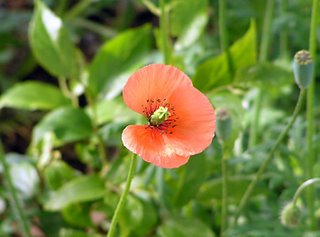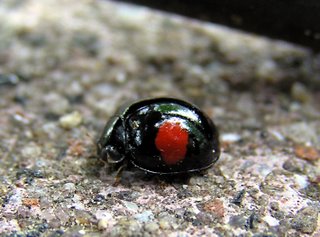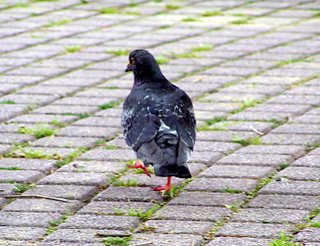Today was my easy day. One class, of first year students. This is the class with the deaf student, which has put a damper on all my plans for them. I had decided to do a LOT of dictation activities - these students have real trouble hearing even the English they 'know.' Having a deaf student in the class has changed my plans.
I had thought I wouldn't read to them, either, but then decided that since she isn't blind, she can read a story even if she can't hear it. So today I started reading them a simplified story. It is a good one, and I have become a better reader since listening to Miette's Bedtime Stories. Miette is a very good reader, and I've picked up some hints from her.
My students did not know I was going to do this, because I hadn't told them until the beginning of class today. I handed out the copies and read the first chapter of the story at the end of class. When I finished reading it, they had the usual expressions students have when I first do this: they looked stunned and dazed, as if they'd just been whacked on the head. I asked if they had followed the story, and most of them said yes, looking very surprised. THEY HAD UNDERSTOOD A STORY IN ENGLISH, AND IT WAS FUN.
I love reading stories to students. I still haven't figured out exactly what the benefits are of this activity, but I know they love it, too, and that is all I need to know, really. Just to see their faces when I finish and they look up, resurfacing from the world they've been unexpectedly immersed in, is enough for me. They are learning SOMETHING. Who cares what?
It was supposed to rain today, but on my way to work it hadn't rained yet so I stopped at the little park near the school, to enjoy the peace and quiet for a moment. I wasn't going to take any pictures. I had the camera, because it is easy to carry when I am on my bicycle, but I thought it was going to rain. However, I did end up taking a few pictures.
The first picture is of a flower. This is a little orange flower which I see everywhere, and I suspect it is a weed. I don't know what it is, though. Even if it is a weed, it is a lovely little flower, and I always notice it.
The second picture is of a bug. It looked like a ladybird, but only had two spots, one on each side. It was hard to take a picture because it kept moving. It was in a real hurry, and I kept getting pictures of spotty blurs. Eventually it stopped, though, and I got one fairly good photo.
While I was trying to photograph the bug, a pigeon approached me. It was a very demanding pigeon.
"Got any food?" it asked, without even saying Excuse me first.
"No," I said.
"Bugger you, then!" said the pigeon, and stomped off.
And that was the end of the conversation. Not exactly a bird story, sorry, but typical of pigeons.
The wisteria at the little park had grown a lot since I saw it last, but was still not flowering. Maybe next week.
Wednesday, May 10, 2006
A story, a bug, a flower and a pigeon
Posted by
Badaunt
at
8:19 pm
12
comments
![]()
Labels: Birds





12 comments:
I love that orange flower. It reminds me of a poppy.
It's fun to read stories in class - I always found it more useful in language classes than doing conversations on tape. At least with a story you can follow the characters, the intent, etc., rather than a random dialogue that is supposed to show you how a certain grammatical tool functions, but you don't then understand it out of that specific context. It's early so I may be off my rocker here, but that's where my brain's at...
I am sure it is a wild field poppy.
They grew in the battlefields because, like weeds, they seed on overturned soil.
See the seed head behind it? when you see the star shape on the top go a good brown and start to lift at the edges, it works like lifting a circle of tiny lids on tubes full of seeds underneath. If you grab it when its ready to open and seed to the wind, then store it in a paper bag, you will have a load of wild poppy seeds for your garden, if you want them.
That bug is so adorable.
Pigeons can be downright rude sometimes.
Definitely a poppy, and probably (as Cheryl says) Papaver rhoeas, also known as corn poppy, and in Japanese apparently hinageshi
http://www.plantnames.unimelb.edu.au/Sorting/Papaver.html
Is it orange orange or more pale red orange?
Can I have a permanent post as supplier of Latin names?
What is the definition of a weed anyhow?
No easy task, photographing small moving bugs *and* staying "focused." Nicely done!
As no one else would attempt it, and I adore you for giving me little puzzles to figure out from time to time, your ladybird is in fact a ladybird (aka 'ladybug' in America, or the 'Asian lady beetle'). Harmonia axyridis, which apart from the coloring of this individual, is the same beneficial bug found just about everywhere else in the world.
I've found that even with my "native speaker" students I have to read aloud to them for them to "get" some works. I nearly had to read the entire novel (The Scarlet Letter) to them because they give up so easily on their own.
Learning a foreign language, doing it mostly by either reading OR listening, then combining them, was a major plateau raising experience for me years ago--something in the research later said it is using more than one of our 5 senses to learn something....so keep doing it! And taking pictures of flowers--we had snow here in Eagle River today......
Kenju: You were right. Aren't you clever!
Wiccachicky: That's the point, or at least one of them, and that's why I read longer stories rather than shorter. The first chapter is the hardest, because there's so much new information. After that, the students know the characters and setting and so on, and have expectations about what will happen next, and that helps with the language. Plus, the language is in context.
Cheryl & Potentilla: I didn't know poppies could be orange! These ones are definitely orange, not reddish orange. I think they're lovely, and the reason I called them 'weeds' is that they don't seem to be cultivated. They grow in parking lots where the gravel isn't thick enough, and by the railway lines, and by the river, and places like that.
Fin: Isn't it cute? The two big red spots are really eye-catching.
Ms Mac: I learned not to feed the pigeons when they got way too rude, and started landing on me. They take LIBERTIES, and before you know it they're treating you like a toilet.
RaJ: You should have seen the OTHER pictures I took of it! There were about twenty spotty blurs on my camera by the time I'd finished.
Tinyhands: I'd glad to hear it's beneficial. Most of the bugs I encounter here are anything but.
Robert: They most likely benefit HUGELY from you reading to them. It sounds like they have never learned to read properly, and certainly never been read to at home. Kids who are read to have a huge advantage over those who are not, I learned (I did a literacy paper as a part of my M.App.Ling). There is a large amount of information (tone, stress, and so on) that is left out of written language, which we automatically put back in when we read silently. If we don't learn how to do it, we are just 'decoding,' which is difficult and time-consuming (and discouraging). The words are 'flat' on the page.
The reading aloud/lips moving stages kids go through as they're learning to read are a part of this learning to put the information back in (and unfortunately I have met people who discourage children from moving their lips when they read). If these kids have never gone through those stages, it's possible that getting them to mumble the words to themselves as they read might help. (Or at least not discouraging them from doing it if they're doing it anyway.) When they don't need to do it anymore, they won't.
In the meantime, reading to them is probably the best thing you could be doing for them, particularly if they're reading along with you (even silently). You are helping them to see that writing is not flat; you are demonstrating levels of information in the written word they probably can't see by themselves yet.
But how discouraging for you, that kids at high school cannot read.
Kay: I intend to do both - the reading and the flowers.
It's funny, I've noticed that whenever I read aloud, even if it's just a short (and often boring) passage in a textbook, even the rowdiest students go totally silent. It seems that just the situation of being read to creates a sort of magic. And I get the feeling there is learning of SOME sort going on - the level of concentration is really intense - but it's hard to pinpoint exactly what it is.
BadAunt,
Story telling is excellent! I can identify with your students...
With my wife being from the Philippines, and all of her immediate family still being there, we decided that we should teach our kids Tagalog so they can interact with their cousins/aunts/uncles/grandparents whenever we return to visit.
So, we decided we will only speak Tagalog in our home (since they will get English from everyone else here!) This is my first serious attempt to learn another language (high school spanish class didn't "take".)
Now my wife is pregnant, which means I've really got to get in gear with my Tagalog studies! So I've begun reading out-loud some romance pocketbooks she brought to the states with her-- silly teenage girl love stories aren't the most exciting to me, but it's making a HUGE difference in my understanding of sentence structure, tenses, etc.
I think reading stories to your students will be a big help.
Post a Comment